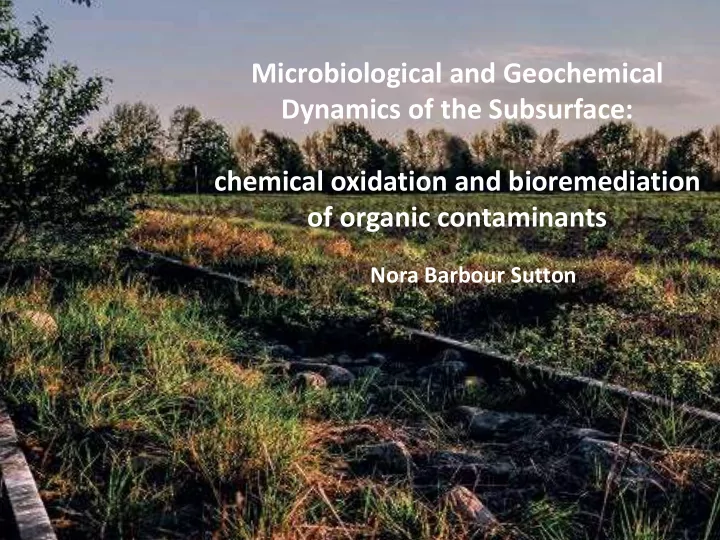

Microbiological and Geochemical Dynamics of the Subsurface: chemical oxidation and bioremediation of organic contaminants Nora Barbour Sutton
Soil Contamination Sources of Contamination Types of Contamination Gas Stations Benzene, diesel, gas Dry Cleaners Solvents: PCE Industrial Factories Heavy Metals Transport Infrastructure Pure Pollutant Pure Pollutant Groundwater Groundwater
Soil Remediation Transfer of PHYSICAL Remediation contaminant Physically remove contaminant from the to second subsurface location CHEMICAL Remediation (chemical oxidation) Contaminants are chemically degraded Conversion of contaminant into harmless products BIOLOGICAL Remediation (Bioremediation) Microorganisms degrade contaminants through biological processes
Conversion: In situ chemical oxidation (ISCO) In situ bioremediation (ISB) CHEMICAL Remediation Benzene + oxidant → CO 2 + H 2 O BIOLOGICAL Remediation (Bioremediation) Benzene + bacteria + O 2 → CO 2 + H 2 O + biomass
Conversion: In situ chemical oxidation (ISCO) In situ bioremediation (ISB) Groundwater
Conversion: Chemical oxidation followed by bioremediation In situ chemical oxidation (ISCO) In situ bioremediation (ISB) Amendments Oxidants Nutrients Fenton’s Reagent H 2 O 2 + Fe 2+ Oxygen Persulfate: S 2 O 8 2- Carbon Source Bacteria Ozone O 3 - Permanganate MnO 4 Groundwater
Chemical oxidation + bioremediation Technological Motivation Parameter Chemical Oxidation Bioremediation (ISCO) (ISB) Time Rapid Slow Cost High Low Pure Pollutant Yes No Thorough No Yes Sustainable No Yes
Chemical oxidation + bioremediation Scientific Reasoning Scientific Challenge • Reduces toxicity • Oxidizing conditions • Improves biodegradability • pH change • Improves bioavailability • Soil organic matter degradation • Increases temperature and mixing Oxidants Optimal pH Oxidation Potential (V) H 2 O 2 + Fe 2+ 2.8 (OH - ·) Fenton’s Reagent 3-4 2- - ·) Persulfate: S 2 O 8 3-4 to >10.5 2.6 (SO 4 Ozone O 3 neutral 2.1 Permanganate MnO 4 - neutral 1.7
Chemical oxidation + bioremediation Scientifically Attractive: unique system to investigate → Fundamental Understanding of Entire System Groundwater Soil Contaminant Microbial Community Groundwater
Dissertation Structure Motivation Chemical Oxidation and Bioremediation Part Three: Part One: Part Two: Review; Anaerobic ISB: Aerobic ISB: limitations to ISB TPH chlorinated ethenes Diesel PCE and TCE bioremediation bioremediation with with oxygen electron donor
Dissertation Structure Motivation Chemical Oxidation and Bioremediation Part Three: Part One: Part Two: Review; Anaerobic ISB: Aerobic ISB: limitations to ISB TPH chlorinated ethenes Literature Laboratory Field
Dissertation Structure Motivation Chemical Oxidation and Bioremediation Part Three: Part One: Part Two: Review; Anaerobic ISB: Aerobic ISB: limitations to ISB TPH chlorinated ethenes Chapter 2 Review of ISCO coupled Literature with ISB Chapter 5 Chapter 8 Chapter 3 Aqueous constituents Bioavailability limitations Development of OHRB impact bioremediation Laboratory to bioremediation Chapter 6 resilience to chemical Microbial community oxidation dynamics following oxidation Chapter 4 Chapter 7 Chapter 9 Field limitations to Geochemical and Changes to OHRB and Field bioavailability microbial community rdh abundance during ISCO changes during ISCO and ISB
Dissertation Toolbox Chapter Aspects 3 4 5 6 7 8 9 soil type X X X System chemical oxidant type X nutrient amendment X X Microbiological microbial community X X X X X X groundwater X X X X soil characteristics X Geochemical contaminant characteristics X X X
Major Conclusions Technological: Chemical oxidation plus bioremediation is very effective
Major Conclusions Technological: Chemical oxidation plus bioremediation is very effective Scientific: Bacteria are very resilient
Major Conclusions Technological: Chemical oxidation plus bioremediation is very effective Scientific: Bacteria are very resilient Chemical oxidation impacts subsurface processes
Major Conclusions Technological: Chemical oxidation plus bioremediation is very effective Scientific: Bacteria are very resilient Chemical oxidation impacts subsurface processes DNA-based tools are essential to understanding system
Major Conclusions Technological: Chemical oxidation plus bioremediation is very effective Scientific: Bacteria are very resilient Chemical oxidation impacts subsurface processes DNA-based tools are essential to understanding system → Fundamental Understanding of Entire System
Program Defense: 13:30-13:45 Presentation 13:45-14:30 Examination by Committee 14:30-14:45 Committee withdraws 14:45-15:00 Announcement of decision Reception: 15:00-15:45 in Aula Dinner and Party: 17:30 Cafe Carre, Vijzelstraat 2
Microbiological and Geochemical Dynamics of the Subsurface: chemical oxidation and bioremediation of organic contaminants Nora Barbour Sutton
Recommend
More recommend